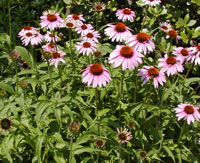 |
| © Bob Lollo |
| Purple Coneflower |
the common Purple coneflower (Echinacea purpurea) is a most versatile, sturdy perennial plant. A wildflower native to the central and southeastern United States, it produces jaunty, colorful blooms in midsummer when many other flowering plants are idle. While it requires moist soil at first, it is fairly drought tolerant when established. It is an excellent plant for attracting butterflies, that visit often and linger long. Purple coneflower is cold hardy, surviving winters as far north as the Canadian border.
Aside from its obvious charm as an ornamental plant, purple cornflower is reputed to have therapeutic value as well. It was a medicinal staple for many Native American prairie peoples and its roots and leaves are ingredients in several over-the-counter herbal preparations currently available in drugstores and health food stores today.
Size: Purple coneflowers grow from 3 to 4 feet tall on straight, coarse, hairy stems. Some newer types are only 2½ feet tall. The plants grow in clumps that spread 2 to 4 inches every year.
Foliage: Purple coneflower leaves are medium green and somewhat fuzzy. From 2 to 12 inches long, they are lance-shaped with pointed tips, prominent veins and toothed edges. They grow alternately along the flower stems.
Flowers: Purple coneflower blossoms are 2½ or more inches across, and resemble daisies. The familiar reddish-purple petals, or “ray” flowers, surround large, dark, centers composed of numerous, densely compacted “disk” flowers. This central “cone” may black, brown, orange bronze or rust colored, depending on the variety. Flowers start to bloom in midsummer at the tips of branching stems, several to a plant. They continue for 2 to 3 months. Then the petals drop and the centers gradually enlarge, becoming dark, bristly cones as the seeds within mature.

